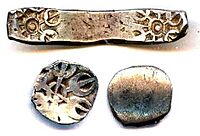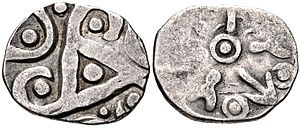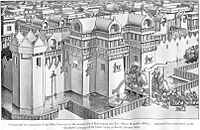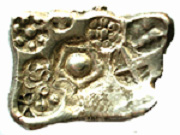Mahajanapadas facts for kids
Quick facts for kids
Mahājanapadas
|
|||||||||||||||||
|---|---|---|---|---|---|---|---|---|---|---|---|---|---|---|---|---|---|
| c. 600 BCE–c. 345 BCE | |||||||||||||||||
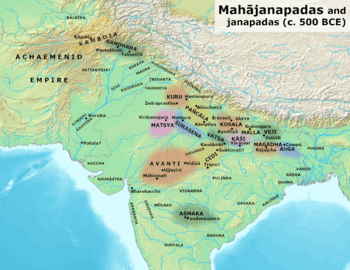
Map of the 16 Mahājanapadas.
|
|||||||||||||||||
| Capital | Various | ||||||||||||||||
| Common languages | Pali, Prakrits, and Sanskrit | ||||||||||||||||
| Religion | Historical Vedic religion Buddhism Jainism |
||||||||||||||||
| Government | Republics (Gaṇasaṅghas) Monarchies |
||||||||||||||||
| Historical era | Iron Age | ||||||||||||||||
|
• Established
|
c. 600 BCE | ||||||||||||||||
|
• Disestablished
|
c. 345 BCE | ||||||||||||||||
|
|||||||||||||||||
| Today part of | India Pakistan Bangladesh Nepal Afghanistan |
||||||||||||||||
The Mahājanapadas (meaning "Great Lands" or "Great Kingdoms") were 16 powerful kingdoms and republics that existed in ancient India. They thrived from about 600 BCE to 345 BCE. This time was important because it was when India saw its first big cities since the Indus Valley Civilization.
Contents
History of the Mahajanapadas
The period between 600 and 500 BCE was a big turning point in early Indian history. This was when India's first large cities grew after the Indus Valley Civilization ended. It was also a time when new religious movements like Buddhism and Jainism started. These new ideas challenged older religious beliefs from the Vedic period.
Some of the Mahajanapadas were republics, called gaṇasaṅghas. This means they were ruled by a group of important families, not a single king. Other Mahajanapadas were monarchies, ruled by kings. Ancient Buddhist writings, like the Anguttara Nikaya, often mention these 16 great kingdoms and republics. They stretched across a wide area, from Gandhara in the northwest to Anga in the east. They also reached Asmaka in the southern part of India. All of them had developed before Buddhism became popular in India.
Archaeologists have found pottery from this time called Northern Black Polished Ware. This pottery helps us understand what life was like in these ancient cities.
What were the Janapadas?
The word "Janapada" means "the foothold of a people." It shows how early groups of people settled down in specific areas. Before the time of the Buddha, northern India was divided into many Janapadas. Each had its own borders. The famous Indian grammarian Pāṇini used "Janapada" to mean "country" and "Janapadin" for its citizens. Each Janapada was named after the Kshatriya (warrior class) people who lived there.
Buddhist and other old texts mention 16 great nations, called Solasa Mahajanapadas, that existed before the Buddha. They don't give a full history of all of them, except for Magadha. The Buddhist text Anguttara Nikaya lists these 16 great states:
Other ancient texts also list Mahajanapadas, sometimes with slightly different names or numbers. For example, the Digha Nikaya mentions 12 from the list above. The Vyākhyāprajñapti (a Jain text) gives a different list of 16. However, the list from the Anguttara Nikaya is the most commonly accepted.
The 16 Mahajanapadas
Aṅga
Anga was an ancient kingdom mentioned in old texts. It was a big center for trade. Its merchants often sailed to distant lands. Anga was later conquered by the powerful kingdom of Magadha during the time of King Bimbisara. This was Bimbisara's only major conquest.
Aśmaka
The country of Assaka or Ashmaka was in southern India. It included parts of what are now Andhra Pradesh, Telangana, and Maharashtra. During the Buddha's time, many Assakas lived near the Godavari River. Their capital city was Potana or Potali. This city is thought to be modern-day Bodhan in Telangana.
Avanti
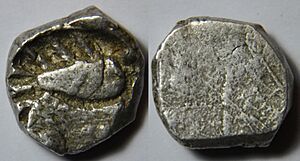
Avanti was an important kingdom in western India. It was one of the four most powerful kingdoms after the time of Mahavira and Buddha. The other three were Kosala, Vatsa, and Magadha. The Narmada River divided Avanti into northern and southern parts. Its capital was Ujjaini, which is now Ujjain. Avanti was a key center for Buddhism. Many important Buddhist teachers lived there. Eventually, Avanti became part of the Magadhan empire.
Chedi
The Chedis were an ancient people. They had two main settlements. One was in the mountains of Nepal, and the other was in Bundelkhand, near Kausambi. Their capital city was Sotthivatnagara, also known as Suktimati. The exact location of Suktimati is still debated by historians.
Gandhāra
-
A coin of Takshashila, showing a tree, a hill, a crescent, and a swastika.
The Gandharas were a strong people, skilled in warfare. Their lands were watered by the Indus River. Two important cities in Gandhara were Taksashila and Pushkalavati. Taxila was a very famous center of learning in ancient times. Scholars from all over the world came there for higher education. Famous thinkers like Pāṇini (a grammar expert) and Kautiliya (a political strategist) studied at Taxila University.
Gandhara was located on a major trade route called the Uttarapatha. This made it a hub for international business. Around the 6th century BCE, King Pukkusati of Gandhara was a contemporary of King Bimbisara of Magadha. Later, Gandhara and Kamboja became part of the Achaemenid Empire of Persia.
Kamboja
The Kambojas lived in regions around the Hindukush mountains. They were often linked with the Gandharas. The capital of Kamboja was likely Rajapura (modern Rajori) in southwest Kashmir. The Kambojas were known for having a republican form of government, meaning they were ruled by a council rather than a king. They were a powerful people, and their land was rich.
Kāśī
The kingdom of Kasi was located around its capital city, Varanasi. This city got its name from the Varuna and Asi rivers that bordered it. Before the Buddha's time, Kasi was the most powerful of the Mahajanapadas. Old stories tell of its great wealth and beauty. Kasi had long struggles for power with the kingdoms of Kosala, Anga, and Magadha. Although Kasi once conquered Kosala, it was later taken over by Kosala during the Buddha's time.
Kosala
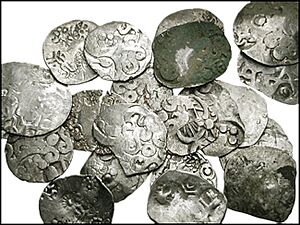
The country of Kosala was northwest of Magadha. Its capital was Ayodhya. Its land covered modern-day Awadh in Uttar Pradesh. The Ganges River formed its southern border, and the Himalaya mountains were to its north.
Later, the famous King Prasenajit ruled Kosala during the time of Mahavira and Buddha. His son, Vidudabha, followed him. King Prasenajit was very educated. He also made an important marriage alliance with Magadha, marrying his sister to King Bimbisara. Kosala eventually became part of the Magadhan empire. Important cities in Kosala included Ayodhya, Saketa, Banaras, and Sravasti.
Kuru
The Kurus were an ancient people mentioned in old texts. Their country roughly covered modern Thanesar, the state of Delhi, and the Meerut district of Uttar Pradesh. Their capital was Indraprastha (Indapatta), near modern Delhi. During the Buddha's time, the Kuru country was ruled by a chieftain. The Kurus were known for their wisdom and good health. Although they were a monarchy earlier, they changed to a republican government between the 6th and 5th centuries BCE.
Magadha

The kingdom of Magadha was one of the most important and successful Mahajanapadas. It covered parts of modern Patna and Gaya in southern Bihar, and parts of Bengal. Its earliest capital was Girivraja or Rajagaha (modern Rajgir). This city was an important center for Jainism. The First Buddhist Council was also held in Rajagaha. Later, Pataliputra became the capital of Magadha. Magadha grew to be the most powerful state in ancient India, taking over many other Janapadas.
Malla
The Mallakas were a powerful people in Northern India. They were a republican people, meaning they were ruled by a group of leaders, not a king. Their land had nine different areas, each with its own group of leaders. Two of their most important cities were Kushinagar and Pava. Kushinagar is very important in Buddhist history because Lord Buddha took his last meal at Pava and died at Kusinara. The Mallakas eventually lost their independence and their lands were added to the Magadhan empire.
Matsya
The country of the Matsya tribe was south of the Kurus. It was west of the Yamuna River, which separated them from the Panchalas. This area roughly matched the former princely state of Jaipur in Rajasthan. Their capital was Viratanagara (modern Bairat). The Matsyas did not have much political power during the Buddha's time.
Pañcāla
The Panchalas lived east of the Kurus, between the mountains and the Ganges River. This area roughly matched modern Budaun and Farrukhabad in Uttar Pradesh. The country was divided into northern and southern Panchala. Northern Panchala's capital was Adhichhatra, and southern Panchala's capital was Kampilya. The famous city of Kanauj was in Panchala. Like the Kurus, the Panchalas also changed from a monarchy to a republican government around the 6th and 5th centuries BCE.
Śūrasena
The country of the Surasenas was east of Matsya and west of the Yamuna River. This area roughly matched the Brij region of Uttar Pradesh. Its capital was Madhura or Mathura. Avantiputra, the king of Surasena, was an important follower of the Buddha. With his help, Buddhism grew in Mathura. Mathura was also known as a center for the worship of Krishna. The Surasena kingdom eventually lost its independence and was taken over by the Magadhan empire.
Vṛji
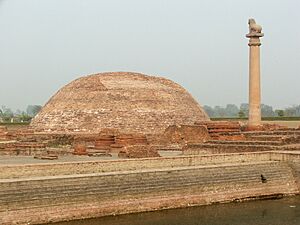
The Vajji or Vṛji was a group of allied clans, including the Licchavis. It was one of the main Mahajanapadas of ancient India. The area they ruled is now part of Mithila in Nepal and northern Bihar. Their capital city was Vaishali. The Vajji state was a republic, meaning it was governed by a council of leaders from different clans.
Vatsa (or Vaṃsa)
The Vatsas or Vamsas were a branch of the Kurus. The Vatsa country was in the area of modern Prayagraj in Uttar Pradesh. It was a monarchy, with its capital at Kausambi. Kausambi was a very rich city where many wealthy merchants lived. It was an important trading hub for goods and travelers from the northwest and south. Udayana was the ruler of Vatsa in the 6th-5th century BCE. He was a powerful king. At first, he was against Buddhism, but later he became a follower of the Buddha and made Buddhism the state religion.
See also
- Achaemenid conquest of the Indus Valley
- Indo-Aryan peoples
- Iron Age in India
- Magadha-Vajji war
- Rigvedic tribes



